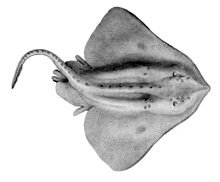
Description:-
Skates are cartilaginous fishes like other Chondrichthyes, however, skates, like rays and other Rajiformes, have a flat body shape with flat pectoral fins that extend the length of their body. A large portion of the skate's dorsal body is covered by rough skin made of placoid scales. Placoid scales have a pointed tip that is oriented caudally and are homologous to teeth. Their mouths are located on the underside of the body, with a jaw suspension common to Batoids known as euhyostyly. Skate's gill slits are located ventrally as well, but dorsal spiracles allow the skate to be partially buried in floor sediment and still complete respiratory exchange.Also located on the dorsal side of the skate are their two eyes which allow for predator awareness. In addition to their pectoral fins, skates have a first and second dorsal fin, caudal fin and paired pelvic fins. Distinct from their rhomboidal shape is a long fleshy slender tail. While skate anatomy is similar to other Batoidea, features such as their electric organ and mermaid's purse create clear distinctions.
Distribution and habitats:-
Skates are primarily found from the intertidal down to depths greater than 3,000 m (9,843 ft).They are most commonly found along outer continental shelves and upper slopes. They are typically more diverse at higher latitudes and in deep-water. In fact, skates are the only cartilaginous fish taxon to exhibit more diversity of species at higher latitudes. A cool, temperate to polar water in the deep sea can be a favorable environment for skates.As the water becomes more shallow and warmer, skates are seen to be replaced by stingrays. Skates are absent from brackish and freshwater environments. However, there is a single estuarine species that has been found in Tasmania, Australia. Also, the Connecticut Department of Environmental Protection has caught and studied skates within the Long Island Sound estuary. Some skate fauna have been found inhabiting areas of rock cobble and high rocky relief.
Behavior and ecology:-
Skates mate at the same nursery ground each year. In order to fertilize the egg, males use claspers, a structure attached to the pelvic fins. The claspers allow them to direct the flow of semen into the female's cloaca. Skates are oviparous, meaning they lay eggs with very little development in the mother. This is one major difference from rays, which are viviparous, meaning they give birth to live young. When a female skate is fertilized, a protected case forms around the embryo called an egg case, or more commonly mermaid's purse. This egg case is then deposited out of the mother's body onto the ocean floor where the skates develop for up to 15 months before they enter the external environment.